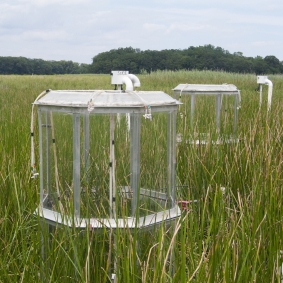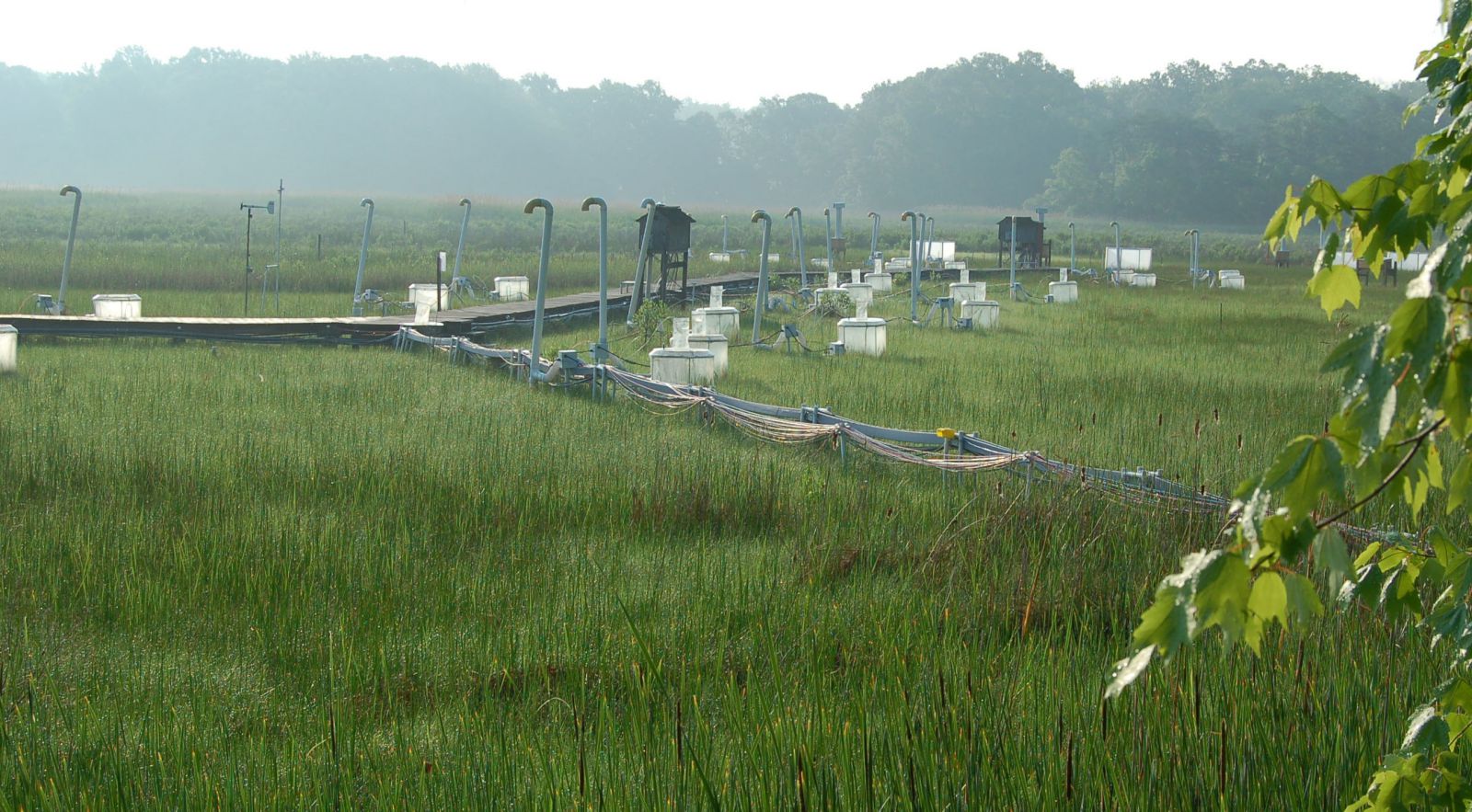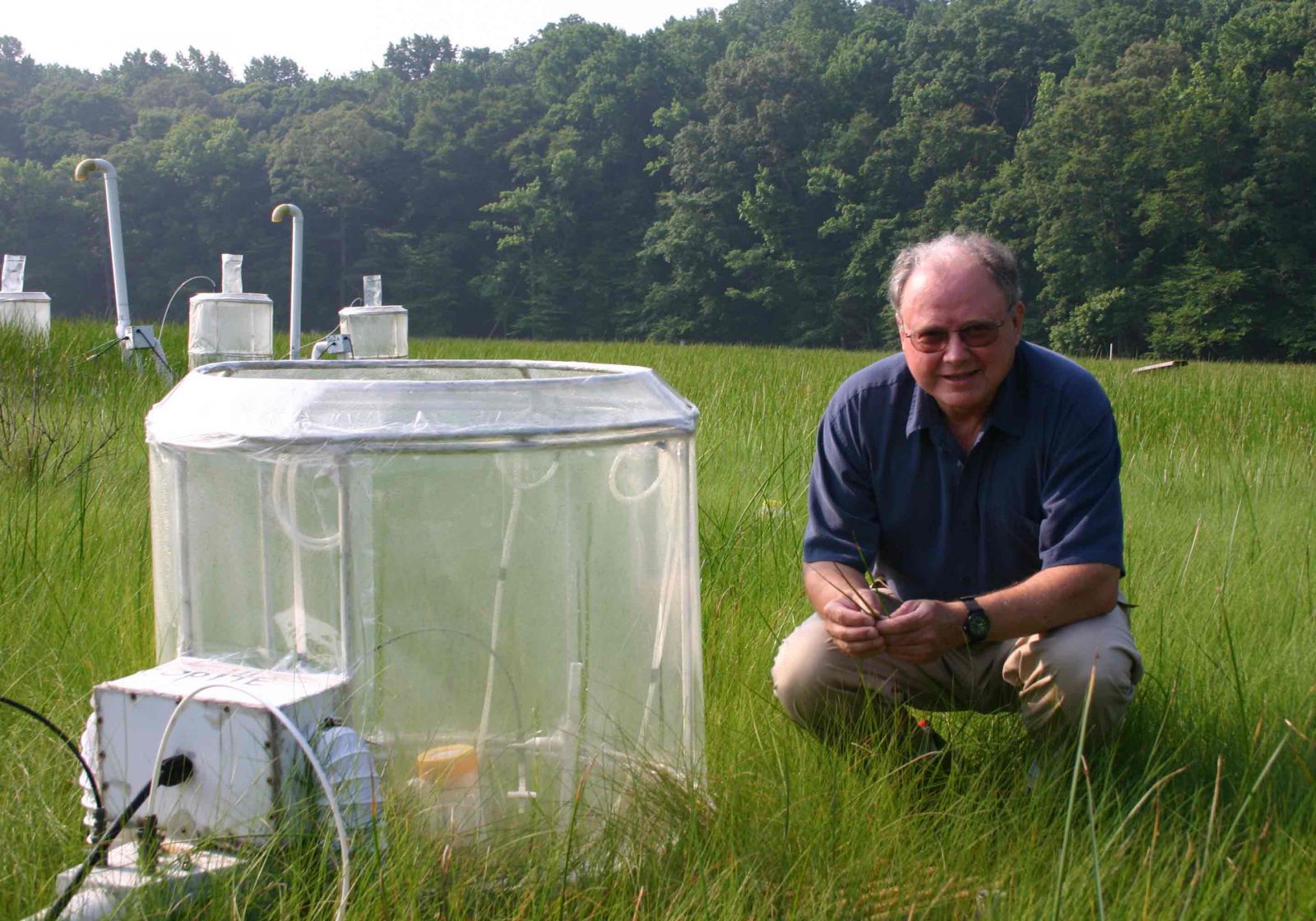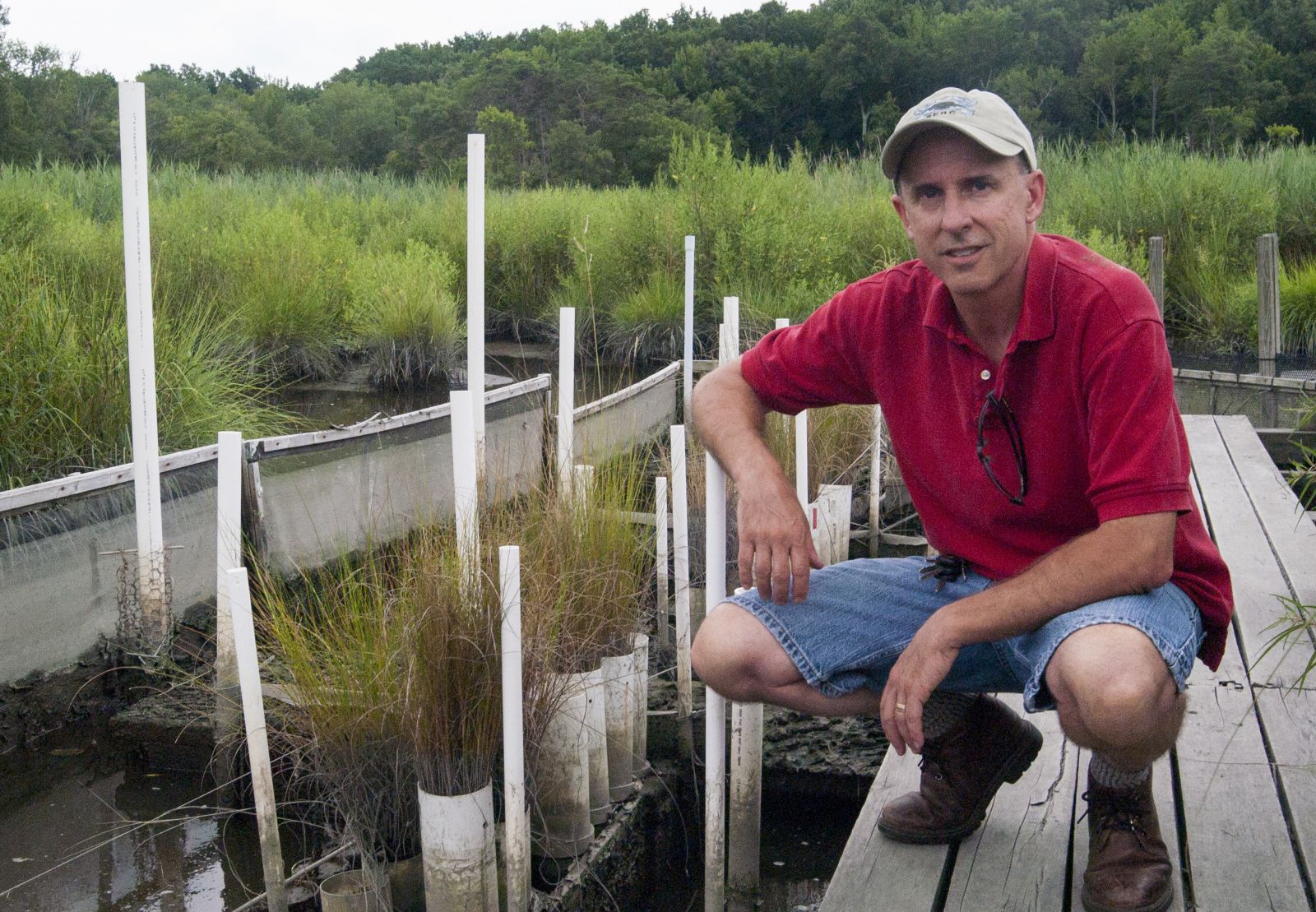Knauss legislative fellowships in Congress help build careers — and they're fun and educational. See our video and fact sheet for details.
Marshes in a Changing World: Part 1

A Two-Decade-Long Study Explores How Marshes Take Up Carbon Dioxide
Kirkpatrick Marsh is nearly impassible. The grasses and sedges grow in so thick that it would take hours to walk unaided through this wetland, which sits on Maryland’s Rhode River. To get through, researchers here have installed a network of raised platforms – like a pirate’s gangplank stretched across hundreds of feet.
“This is a luxury,” says Patrick Megonigal, a biogeochemist at the Smithsonian Environmental Research Center (SERC), which manages the wetland. He’s walking down the pathway now. The planks – he calls them a “boardwalk” – are made of tough plastic and are about as wide as a city sidewalk. And they allow him and his colleagues to get to the middle of the marsh – without bushwhacking.
Off the boardwalk, you can spot a host of strange-looking pods. The pods, which are covered in clear plastic and look like greenhouses in miniature, range in size from beer keg to above-ground swimming pool.
And for around two decades on this marsh, scientists have used the odd contraptions to explore an important dilemma: how will ecosystems respond as carbon dioxide (CO2) levels in the atmosphere continue to climb? Inside each of these open-top containers, the scientist explains, grasses and sedges are growing just like they would across the marsh. But in some of these chambers, the researchers have been pumping in an extra dose of CO2. It’s an attempt to simulate the atmospheric conditions that these plants are expected to face later this century.
 |
| Kirkpatrick Marsh's "boardwalk" stretches over hundreds of feet and past several study sites. Credit: Smithsonian Environmental Research Center. |
Scientists at Kirkpatrick Marsh are exploring what will happen to these plants as CO2 levels in the atmosphere soar. Grasses and sedges naturally take up CO2 during photosynthesis, turning this molecule into the energy they need to grow. And CO2, emitted by factories and cars, is a potent greenhouse gas and the primary driver of climate change. In other words, this ecosystem acts like a soggy, green sponge: as the plants grow, they draw in human greenhouse gas emissions from the atmosphere, potentially helping to slow the warming of the planet.
But just how much CO2 this marsh, and others like it, can ultimately take up isn’t clear. That’s what scientists on Kirkpatrick Marsh are hoping to find out.
Now, a team of researchers have published a landmark study, detailing data taken over 19 years at the marsh since the experiment’s beginning in 1987. The group’s findings suggest that wetlands do, in fact, make good carbon sponges – the more CO2 you give them, the thicker they grow and the more carbon they absorb. It’s another piece of evidence showing how much good marshes can do for the planet – and why the steady loss of marshes is a problem that needs attention.
But what happens to all that carbon over the long haul, after marsh plants capture it, is still uncertain. Does it trickle back into the atmosphere when the plants die and decompose? Or is some of it stored for years or even decades in the soil?
Wetlands “take up a lot of carbon,” says Richard Phillips, an ecologist at Indiana University in Bloomington, who studies how forests take up and store carbon. “But the real question is what is the fate of that carbon.”
Green Scum
The Kirkpatrick Marsh project got its start in the early 1980s as Bert Drake, an ecologist at SERC, was mulling over the question of how local wetlands might be affected by rising CO2 levels. At the time, the relationships between natural ecosystems and greenhouse gases in the atmosphere were poorly known.
Many scientists who were working to project the future of the Earth’s climate “considered the green stuff on the Earth just a scum surface . . . that had little or no effect on what they were doing,” says Drake, who is now retired. “But that, of course, is really too simple minded.”
Plant scientists, for instance, had long known that when you grow plants in a greenhouse in air enriched with CO2, most grow bigger than usual. It’s like a weightlifter sucking down high-energy shakes. The plants took up the extra carbon and used it to build larger leaves, stems, and roots. If the same phenomenon happened in working ecosystems, such as forests or marshes, Drake reasoned, it could have a noticeable impact on CO2 levels in the atmosphere. Theoretically at least, natural ecosystems could help to slow the rise of CO2 emissions – if only just a bit.
|
|
|
Bert Drake next to one of his team's pods. Credit: Smithsonian Environmental Research Center. |
So Drake decided to test just how useful the planet’s green stuff could be. His team set up shop in the marsh, installing the first pods and building hundreds of feet of raised planks, which made up the rickety precursor to Megonigal’s boardwalk. The experiment started up in 1987. To get the project up and running “was a hell of an undertaking,” Drake says.
That undertaking largely focused on two plants in particular: the sedge Scirpus olneyi, which has thin leaves that poke up like stiletto blades, and Spartina patens, a grass that grows in thick mats. Both are plentiful in Kirkpatrick Marsh and are among the reasons why the wetland is so hard to ford.
To simulate future conditions, the team flooded a subset of the pods with air carrying 680 parts per million of CO2 – or around double the atmospheric levels seen in the 1980s. At the start of the experiment, many researchers thought that it would take a century or more to hit such a high number, but as CO2 levels continue to soar, “that 680 parts per million is going to happen much sooner than we thought,” Drake says. In 2013, CO2 levels in the atmosphere topped 400 parts per million for the first time in the history of the human race. And those emissions are continuing to rise.
There’s little doubt that such sky-high levels of CO2 will be bad for many marsh plants in the future. In part, that’s because scientists suspect that warming temperatures may harm many plants. Rising sea levels, another outcome of climate change, also threaten to deluge many wetland communities. But in the short term, all that carbon seemed to do the plants some good.
Over the 19 growing seasons, Drake and his colleagues periodically observed how much carbon the plants in the pods were taking up. They did that by measuring the concentration of CO2 going into the pods and seeing how much was left in the air as it trickled out. It was as if they were watching the ecosystem taking a series of deep breaths.
Drake’s sedges benefitted from the extra carbon the most. When these plants were exposed to normal CO2 levels, they took up around 1.9 kilograms of carbon each year on average across every square meter of marsh area. But under enriched CO2 conditions, that number jumped to 2.5 kilograms per year on average, an increase of 32 percent. Even under normal levels of CO2, the sedge communities absorbed carbon at a faster rate than many forest ecosystems studied in a similar fashion.
The marsh grasses – which conduct photosynthesis in a different way than the sedges –increased their CO2 uptake by a less impressive 13 percent. The scientists published their results in summer 2013 in the journal Global Change Biology.
On the surface, that might seem like a silver lining to the climate change story. That is, the more humans pollute, the harder natural ecosystems will work to clean it up. But it’s a razor-thin silver lining. Saltwater marshes as a whole certainly take up an impressive amount of carbon – one rough estimate suggests that the world’s tidal marshes store more than 40 billion metric tons of carbon per year. But humans now emit nearly 700 times more CO2 annually. The relatively small increases in carbon uptake by marsh plants that Drake had seen wouldn’t make much of a dent in that toll.
“The picture is not very good when it comes to looking at terrestrial ecosystems as being our great hope for saving us from putting too much carbon dioxide into the atmosphere,” Drake says.
The Fate of Carbon
Ecosystems can help capture CO2, especially when deployed alongside other strategies for fighting climate change. But in order for plant communities to effectively slow the rise of human emissions, they need to not only take up CO2 – but hang onto it, too.
Finding out how much carbon marshes store, or “sequester,” over long time spans is one of Patrick Megonigal’s pursuits. He keeps a visual aid to make his points. The scientist, who joined the Kirkpatrick Marsh project in the 1990s and has since taken over its direction from Drake, is standing in his lab, which abuts the marsh’s long grasses. He displays a clear, plastic cylinder that’s about five feet tall and as wide as a cantaloupe. It looks like a glass terrarium. And inside is soil.
It’s soil from Kirkpatrick Marsh, Megonigal explains. He and his colleagues had dug up this core in a single swoop. The layers of that dirt trace the history of the marsh for hundreds of years up to the present. The soil in this the core has the same deep brown color as garden compost, indicating that it is rich in carbon.
Megonigal points to the top eight inches or so of the cylinder. “Over the course of a century, [the marsh] has accumulated this much additional carbon, taken out of the atmosphere and stored,” he says. “That’s ‘blue carbon.’”
|
|
|
Patrick Megonigal kneels next to an inlet on Kirkpatrick Marsh. Credit: Daniel Strain. |
Blue carbon is a whimsical name coined by scientists to describe all of the carbon globally that’s been locked up this way inside watery communities, and especially marshes, mangrove forests, and seagrass beds. In an average year, Kirkpatrick Marsh lays down a layer of it around 3 millimeters thick, Megonigal says. As plants here die and decompose, much of the carbon they captured from the atmosphere is digested by microbes and returned to the atmosphere as CO2 gas. Some carbon, however, is not lost – it is added to the soil and kept there for ages.
Megonigal says that the amount of blue carbon stored along the fringes of oceans – in marshes, mangrove forests, and seagrass beds – has been underappreciated by many scientists. In part, that’s because these ecosystems occupy such a narrow sliver of land and sea around the world, amounting to about two to six percent of the area taken up by the planet’s tropical rainforests. But, he adds, “within the vast ocean, these tidal wetlands and seagrasses . . . are hotspots where carbon is stored and sequestered.”
Even though these fringe communities are narrow, they do more than their fair share of capturing greenhouse gas emissions. The reason comes down largely to water: marshes and mangrove forests alike are partially immersed in water for much of the year. That fluid, in turn, slows down the natural processes that are responsible for converting carbon in the soil back to gaseous CO2. Soil exposed to air often loses CO2 at a faster rate. Megonigal estimates that temperate marshes put around five percent of the carbon they take up each year into their vault-like soils. That number sounds small, but most forests, which aren’t soaked in water, manage less than that, maybe around two percent, Megonigal says.
This means that the loss of wetlands has a large impact on the world’s stores of carbon. Looking at wetlands like Kirkpatrick Marsh around the world, Megonigal and a team of international scientists tried to estimate that toll in a paper published in the journal PLoS ONE in 2012. The team calculated that every year, one to two million acres of tidal wetlands around the world are lost to development, sea level rise, and other disturbances. At that rate, human activities could claim one-third or more of the globe’s marshes within the next 100 years.
And as those marshes disappear, much of the carbon they were holding onto will trickle back into the environment. Eventually, some of that lost carbon will return to the atmosphere as CO2. The researchers suggest that the loss of the planet’s wetlands could move around 240 million metric tons of carbon from marsh soils to the air each year. This estimate draws from research done in wetlands around the world, including Kirkpatrick Marsh.
Megonigal notes that many unknowns remain about just how much carbon marshes and other ecosystems can hold. As seen with the sedges and grasses in Kirkpatrick Marsh, some species are greedier for CO2 than others. That makes it difficult to predict, based on studying only a few species, how much carbon an entire ecosystem, filled with many different species, can absorb.
Rising temperatures and sea levels plus a host of other considerations may also influence an ecosystem’s ability to draw in and hold onto carbon, says Richard Phillips of Indiana University. Scientists are “trying to figure out the extent to which different environmental factors all occurring at the same time affect carbon dioxide [storage],” Phillips says. “It gets complicated when you try to project out what this means on a global level.”
Still, Drake and Megonigal’s work certainly highlights the importance of protecting Maryland’s existing marshes. Below the surface, each one is holding onto a megadose of carbon. Restoring new wetlands also helps to remove CO2 from the atmosphere – even though the benefits are small at the global level.
Drake, at least, is confident that his long-running study proves one thing: wetlands and other ecosystems are not just a scum on the surface of the Earth. They can, in profound ways, respond to and even alter the growth of greenhouse gas levels in the atmosphere. As for his 20 years of work on Kirkpatrick Marsh, he says, “It was really exciting to be able to work on something with clear and direct meaning.”





